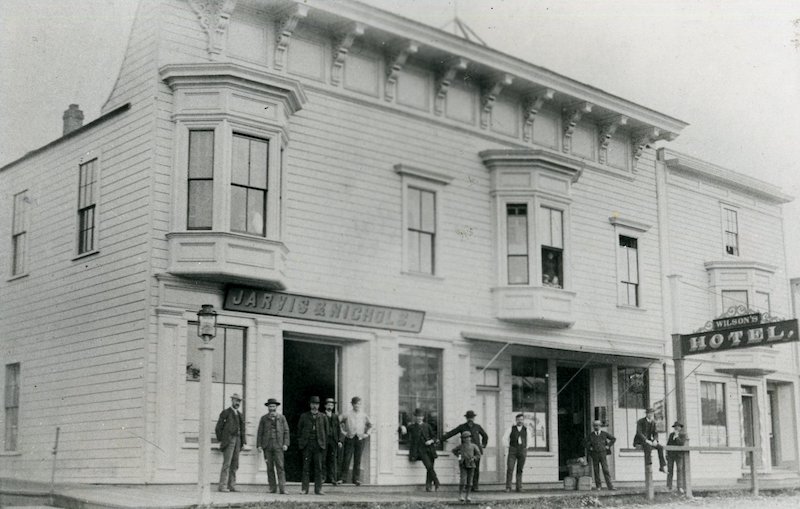June 24, 1893 – The Barry Building was relocated from its site on Main Street to the corner of Albion and Howard Streets. Henry McKenzie moved the three-story building down Main Street to its new location on large wooden rollers. In the 1970s, local historian Nannie Escola shared that her mother had let her go down to Main Street to watch the horses pull the building along.
The Barry Building was originally the barber shop and home of John Barry, and was located in the now landscaped area just east of the Jarvis & Nichols Building (today’s Gallery Bookshop). In 1883, John hired A. F. Carmichael to expand the building, making it 25 feet wide, 50 feet deep, and three stories tall. This expansion allowed for more space to accommodate his shaving parlor and bathing rooms.

The Jarvis & Nichols building on the corner of Kasten and Main Streets in Mendocino, 1883 – 1889. The Jarvis & Nichols Store operated in the western end of the building, and Wilson’s Hotel occupied the eastern end. The adjacent Barry Building can be seen on the right.
The following year, John and his wife Amelia sold the property to W. T. Wilson, the owner of a hotel and restaurant located in the adjacent eastern portion of the Jarvis & Nichols Building. Wilson connected the Barry Building to his restaurant, creating a large airy dining room in the newly expanded space. Meanwhile, the barbershop continued its operations under new management. In 1888, Wilson sold his hotel and the barbershop to Captain Henry Nelson.
Five years later, Henry Jarvis and James Nichols purchased the hotel and barbershop properties from Captain Nelson, planning to expand their store into the entire first floor of the Jarvis & Nichols building. They sold the Barry Building to George Switzer, who had the structure moved to his lot on the northwest corner of Howard and Albion Streets, where it would serve as his residence.
The Barry Building was a private residence until 1977, when Cliff Sanders applied for permits to rehabilitate the structure. In 1979, the Headlands Inn opened to the public with “seven guest rooms, parlor and country kitchen … Dick Foreman and George Webb worked long and hard to transform that tired old home into a good looking and well appointed inn.”
New Exhibit! “Water Tower Wonderland” Discover the beauty, ingenuity, and architecture of these iconic structures in the Kelley House Museum’s summer exhibit, “Water Tower Wonderland.” Using historic photographs, original pieces from local artists, and small-scale models, the exhibit explores the majesty and functionality of many well-known water towers, several still standing and some that aren’t. On display will be renderings of Mendocino water towers in several media, with serigraphs by Anne Kendall Foote and Bill Zacha, a quilt square by Dee Goodrich, and a linocut by Emmy Lou Packard. The Kelley House has also been working closely with Mendocino High School, and the exhibit includes pastels and architectural models made by students. 45007 Albion Street, Mendocino. Thursday-Monday, 11am – 3pm. Now until September 18.